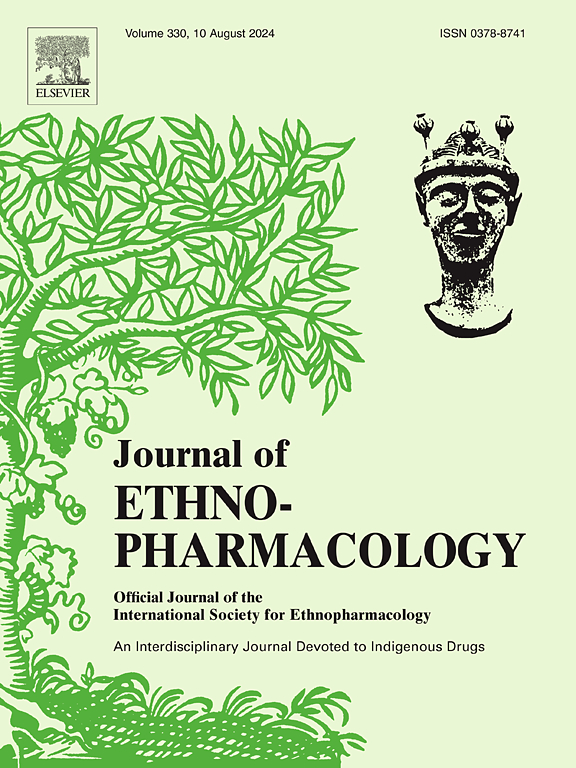当归六黄汤通过抑制JAK2/STAT3介导的炎症改善内皮功能障碍。
IF 4.8
2区 医学
Q1 CHEMISTRY, MEDICINAL
引用次数: 0
摘要
民族药理学相关性:血管内皮功能障碍(VED)被认为是引发糖尿病血管并发症的关键因素。当归六黄汤(DGLHD)已显示出减轻这些并发症的潜力。然而,DGLHD在增强内皮功能方面的临床疗效,以及其缓解2型糖尿病相关血管内皮功能障碍(T2DM-VED)的分子机制仍未得到充分了解。研究目的:本研究旨在通过临床研究验证DGLHD对T2DM-VED的治疗效果。进一步分析DGLHD的药效学基础和分子机制,阐明DGLHD减轻2型糖尿病(T2DM)患者VED的生物学过程。材料与方法:本研究招募“阴虚火上证”、伴有2型糖尿病的动脉粥样硬化性心血管疾病(ASCVD)高危人群。通过酶联免疫吸附试验(ELISA)和血流介导扩张(FMD)检测促炎因子水平,评估DGLHD对T2DM血管内皮功能的影响。采用UHPLC-Q-Exactive Orbitrap系统对DGLHD的主要成分进行了分析。利用网络药理学和分子对接分析预测了DGLHD的潜在治疗靶点。为了验证DGLHD对T2DM-VED的作用机制,我们利用人脐静脉内皮细胞(HUVECs)建立了内皮损伤和炎症细胞模型。建立糖尿病内皮损伤小鼠模型,观察DGLHD对促炎因子的影响,并通过免疫组化观察血管内皮因子的影响。此外,通过Western blot实验观察其对JAK2/STAT3信号通路的影响。结果:DGLHD含有201种有效成分。网络药理学分析表明,DGLHD治疗T2DM-VED与JAK2/STAT3信号通路的调节有关。分子对接分析表明,DGLHD中的小分子与JAK2和STAT3相互作用。我们的临床研究表明,DGLHD可显著降低糖尿病患者的促炎因子水平,改善FMD读数,从而缓解T2DM-VED。DGLHD可抑制JAK2和STAT3的磷酸化,从而阻断JAK2/STAT3信号通路的传递,减少促炎因子和血管内皮生长因子的释放,在体内和体外均可阻止炎症反应。结论:本研究证实了DGLHD在改善ASCVD高危T2DM患者内皮功能方面的潜在疗效。DGLHD通过抑制JAK2/STAT3信号通路,有效减少促炎因子和血管内皮生长因子的释放,缓解VED。本文章由计算机程序翻译,如有差异,请以英文原文为准。

Danggui Liuhuang Decoction ameliorates endothelial dysfunction by inhibiting the JAK2/STAT3 mediated inflammation
Ethnopharmacological relevance
Vascular endothelial dysfunction (VED) is recognized as a key triggering diabetic vascular complications. Danggui Liuhuang Decoction (DGLHD) has shown potential in mitigating these complications. However, the clinical efficacy of DGLHD in enhancing endothelial function, as well as the molecular mechanisms underlying its alleviation of Type 2 Diabetes-Related Vascular Endothelial Dysfunction (T2DM-VED), remains insufficiently understood.
Aim of the study
This study aims to validate the therapeutic efficacy of DGLHD in ameliorating T2DM-VED through clinical research. Furthermore it seeks to analyze the pharmacodynamic basis and molecular mechanisms of DGLHD, elucidating the biological processes through which DGLHD alleviates VED in type 2 diabetes mellitus (T2DM).
Materials and methods
Patients diagnosed with “Yin deficiency with hyperactive fire syndrome”, who are at a high risk for atherosclerotic cardiovascular disease (ASCVD) associated with T2DM, were recruited for this study. The effect of DGLHD on vascular endothelial function in T2DM was assessed by measuring the levels of pro-inflammatory factors through enzyme-linked immunosorbent assay (ELISA) and flow-mediated dilation (FMD). The primary components of DGLHD were analyzed using the UHPLC-Q-Exactive Orbitrap system. Potential therapeutic targets of DGLHD were predicted using network pharmacology and molecular docking analysis. To validate the mechanism of DGLHD on T2DM-VED, endothelial injury and inflammation cell models were established using human umbilical vein endothelial cells (HUVECs). A mouse model of diabetic endothelial injury was also developed to observe the effects of DGLHD on pro-inflammatory factors and vascular endothelial factors were observed through immunohistochemistry. Additionally, the effects on the janus kinase 2 (JAK2) / signal transducer and activator of transcription 3 (STAT3) signaling pathway were observed through Western blot experiments.
Results
DGLHD was found to contain 201 active components. Network pharmacology analysis indicated that the treatment of T2DM-VED with DGLHD is associated with modulation of the JAK2/STAT3 signaling pathway. Molecular docking analysis demonstrated that small molecules in DGLHD interact with JAK2 and STAT3. Our clinical study demonstrated that DGLHD significantly reduces the levels of pro-inflammatory factors and improves FMD readings in diabetic patients, thereby alleviating T2DM-VED. DGLHD was shown to inhibit the phosphorylation of JAK2 and STAT3, which blocks the JAK2/STAT3 signaling pathway transmission, reducing the release of pro-inflammatory and vascular endothelial growth factors, and preventing the inflammatory response in vivo and in vitro.
Conclusion
This study demonstrates the potential efficacy of DGLHD in improving endothelial function in T2DM patients at high risk for ASCVD. By inhibiting the JAK2/STAT3 signaling pathway, DGLHD effectively reduces the release of pro-inflammatory factors and vascular endothelial growth factors, alleviating VED.
求助全文
通过发布文献求助,成功后即可免费获取论文全文。
去求助
来源期刊

Journal of ethnopharmacology
医学-全科医学与补充医学
CiteScore
10.30
自引率
5.60%
发文量
967
审稿时长
77 days
期刊介绍:
The Journal of Ethnopharmacology is dedicated to the exchange of information and understandings about people''s use of plants, fungi, animals, microorganisms and minerals and their biological and pharmacological effects based on the principles established through international conventions. Early people confronted with illness and disease, discovered a wealth of useful therapeutic agents in the plant and animal kingdoms. The empirical knowledge of these medicinal substances and their toxic potential was passed on by oral tradition and sometimes recorded in herbals and other texts on materia medica. Many valuable drugs of today (e.g., atropine, ephedrine, tubocurarine, digoxin, reserpine) came into use through the study of indigenous remedies. Chemists continue to use plant-derived drugs (e.g., morphine, taxol, physostigmine, quinidine, emetine) as prototypes in their attempts to develop more effective and less toxic medicinals.
 求助内容:
求助内容: 应助结果提醒方式:
应助结果提醒方式:


